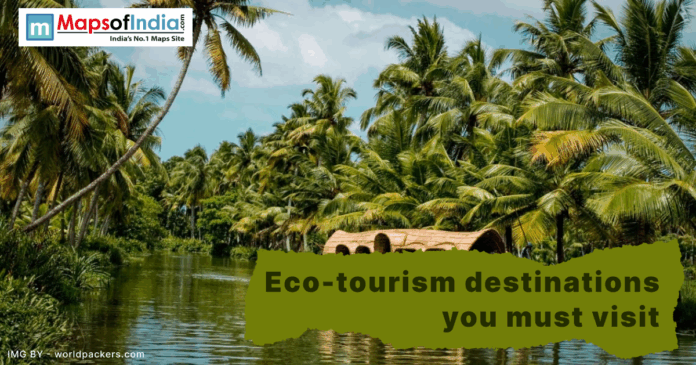Eco-tourism promotes sustainable travel. It conserves environments and supports communities. In 2025, the market will reach $1.2 trillion. Destinations focus on low-impact activities. They educate visitors on conservation. From rainforests to reefs, these spots protect biodiversity. A 2024 UNWTO report says eco-tourism accounts for 10% of global tourism. It generates $1 trillion in revenue. Travellers seek meaningful experiences.
Costa Rica: Biodiversity Hotspot of Central America
Costa Rica is an eco-tourism pioneer. It hosts 5% of global biodiversity. According to the recent report by the World Wildlife Fund, in this biodiversity, over 500000 species are thriving. These national parks cover 25% of the land here. Monteverde Cloud Forest Reserve is iconic. It has 2,500 plant species. A 2024 National Geographic article notes 400 bird types. Activities include zip-lining and birdwatching. The best time is from December to April for dry weather. The rainy season from May to November brings lush greenery. Fly to San Jose Airport. Drive 3 hours to Monteverde. Stay at eco-lodges like Hotel Belmar for $150 nightly. Tips include insect repellent and guided tours. Conservation fees collected from tourists are supporting the park to sustain itself. This model, implemented in Costa Rica, is inspiring eco-tourism across the globe.
Galápagos Islands, Ecuador: Darwin’s Living Laboratory
The islands in the Galápagos are recognized as a UNESCO World Heritage Site. There are a total of 19 islands, which are home to many unique wildlife. According to the recent UNESCO report, 97% of the land in this area is a protected park. Endemic species like giant tortoises number 15,000. A 2024 WWF article notes 400 fish species. Activities include snorkelling with sea lions. Boat tours explore Darwin’s finches. The best time is June to November for cooler weather. December to May brings warmer seas. Fly to Quito, then to Baltra Airport. Cruises cost $3,000 for 7 days. Stay in Santa Cruz at eco-hotels like Finch Bay for $200 nightly. Try to avoid using plastic while visiting here. Conservation efforts protect 95% marine areas.
Amazon Rainforest Brazil: Lungs of the Earth
The Amazon is the world’s largest rainforest. It covers 5.5 million square kilometres. A 2025 NASA Earth Observatory report says it absorbs 2 billion tons of CO2 yearly. Biodiversity includes 3 million insect species. A 2024 WWF article notes 10% of known wildlife. Activities include canopy walks and river cruises. Spot pink dolphins and sloths. The best time is from June to November for lower water levels. During the rainy season, which happens from December to May cause floods occur in many areas. Manaus is the nearest Airport. Before visiting here, get the vaccinations for yellow fever. Use mosquito nets while sleeping. Eco-tourism in the Amazon rainforest supports indigenous communities. It combats deforestation.
Great Barrier Reef, Australia: Underwater Wonderland
The Great Barrier Reef is the largest coral system. It spans 2,300 kilometres. A 2025 UNESCO report says it’s home to 1,625 fish species. Over 600 coral types thrive. A 2024 Australian Marine Conservation Society article notes 411 hard corals. Activities include snorkelling and glass-bottom boats. See turtles and sharks. The best time is June to October for clear water. Summers bring jellyfish. Fly to Cairns Airport. Day trips cost $200. Stay at eco-resorts like Heron Island for $250 nightly. Do not touch coral. The reef generates $6.4 billion in tourism yearly.
Masai Mara, Kenya: African Wildlife Spectacle
The Masai Mara is Kenya’s premier reserve. It covers 1,510 square kilometres. A 2025 Kenya Wildlife Service report says it hosts the Great Migration. 1.5 million wildebeest cross yearly. A 2024 WWF article notes 95 mammal species. Activities include hot air balloon safaris. Spot the Big Five: lions, elephants, leopards, rhinos, buffaloes. The best time is July to October for migration. Dry season aids viewing. Fly to Nairobi, then to Mara airstrip. Lodge stays cost $500 nightly. Tips include anti-malaria meds. Respect the Masai culture. Eco-tourism supports conservation. It generates $1.2 billion of revenue for Kenya.
Torres del Paine, Chile: Patagonian Wilderness
Torres del Paine is Chile’s natural jewel. This wildlife sanctuary spans over 181414 hectares of area. A recent UNESCO report lists it as a Biosphere Reserve. Glaciers and lakes define this place. A 2024 National Geographic article notes 15 mammal species, like pumas. Activities include the W Trek for 50 miles. The best time is December to March for summer. Winters are harsh. Fly to Punta Arenas, then drive 5 hours. Lodge stays cost $300 nightly. Tips include sturdy boots. Pack for wind. Conservation limits visitors to 80,000 yearly. This park showcases Patagonian beauty.
Amazon Rainforest Peru: Biodiversity Powerhouse
Peru‘s Amazon is an eco-tourism hub. Manu National Park covers 1.5 million hectares. A 2025 UNESCO report says it’s the most biodiverse place. 10% of the world’s bird species live here. A 2024 WWF article lists 1,300 birds. Activities include canopy towers for monkey spotting. Boat rides on Oxbow lakes. The best time is May to September for dry trails. Wet season floods but boosts wildlife. Fly to Cusco, then to Manu airstrip. The Amazon rainforest is supporting indigenous tribes in Peru with the natural resources available here. This place generates $200 million via tourism.
Svalbard, Norway: Arctic Adventure
Svalbard is Norway‘s polar paradise. It spans 61,022 square kilometres. A 2025 Norwegian Polar Institute report says 2,654 residents. Polar bears number 3,000. Activities include dog sledging and northern lights viewing. The best time is March to May for light. Summers melt ice. Conservation efforts are protecting 65% of nature reserves. This place can give you the nearest view of Arctic wildlife.
Why These Destinations Matter
Eco-tourism conserves nature. Costa Rica’s parks protect 5% biodiversity. Galápagos preserve 97% of the land. Amazon absorbs 2 billion tons of CO2 yearly. The Great Barrier Reef hosts 1,625 fish species. The Masai Mara sees 1.5 million migrating animals. Torres del Paine spans 181,414 hectares. Peru’s Manu habitat has 1300 birds. Svalbard is home to 3000 polar bears. Galápagos inspired evolution theory. The Masai Mara generates $1.2 billion. A 2025 UNWTO report says eco-tourism is 10% of global tourism. These eco-friendly tourist destinations promote sustainability.
Conclusion
Eco-tourism destinations should grow in the coming years. This trend connects us with the environment and gives us a unique insight into these places. Costa Rica’s Monteverde has more than 2500 plants. Galápagos’ endemic species amaze. Amazon’s biodiversity is unmatched. Great Barrier Reef’s corals dazzle. Masai Mara’s migration thrills. Torres del Paine’s glaciers impress. Peru’s Manu is a bird paradise. Svalbard’s Arctic wildlife enchants. The Masai Mara offers a unique view of the wildlife. A 2025 Allied Research report says $1.2 trillion market. These spots conserve and educate. Plan your eco-adventure today.





